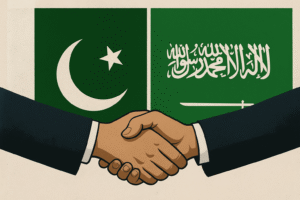Mastering the Skies: The Role, History, and Future of Air Power

Air power has revolutionized the conduct of military operations and become a vital component of military strategy and doctrine. Since its induction in warfare during WW1, it played a pivotal role in shaping the conflict dynamic[1].
Moreover, in contemporary times, air power offers a significant advantage to states in maintaining deterrence in various air situations. It also assists states in achieving strategic, tactical, and operational military objectives, thanks to its characteristics of speed, reach, firepower, penetration, precision, flexibility, and synergy[2].
Air power is defined as the “ability to use airspace for offensive and defensive purposes and deny its use to the enemy.” It includes the use of military aircraft and other projectiles in warfare, while the functions of air power include air supremacy, strategic bombing, air interdiction, close air support, reconnaissance and surveillance, air mobility, search and rescue, and deterrence.
Therefore, its reach extends beyond combat to include disaster relief, humanitarian assistance, and support for local authorities. The paper explores its evolution, various functions, its integration with land and maritime forces, and the characteristics and limitations of air power. The paper concluded with the argument that, due to its diverse functions and capabilities, “Air power is inherently an offensive power[3].”
Evolution of Air Power:
The notion of air power has evolved drastically since WWI; that’s why scholars believe it has brought about a revolution in military affairs (RMA)[4]. Dating back to World War 1, it has been primarily used for reconnaissance, but with a short period of time during the interwar period, its scope rapidly extended to include air-to-air fights and ground attacks. Moreover, during World War II, it has become a critical aspect that influences the tactics of warfare and acts as a major factor for shaping the outcome of battles. Strategic bombing campaigns during WW2 aimed to cripple the infrastructure and morale of the adversary.
Furthermore, the U.S-USSR rivalry during the Cold War era significantly contributed to the development of air power, with both states heavily investing to gain an advantage over each other. Both states emphasize the strategic scope of air power, leading to the development of advanced fighter jets and nuclear-capable bombers. Furthermore, in the recent decade, the capabilities of air power have revolutionized globally due to technological advancements such as stealth technology, precision-guided munitions (PGMs), and unmanned aerial vehicles (UAVs) like drones[5].
Function of Air Power:
The function of air power is not only limited to all three level of military operation like strategic, Tactical and operational level but scope extended to non-military function like disaster relief and humanitarian assistance.
Strategic Function:
The strategic function of air power aims to achieve long-term national and military aims by leveraging air capabilities on an extensive, impactful scale. The strategic function of air power comprises “strategic deterrence”, which avoids adversaries’ actions by showcasing decisive response capabilities, including nuclear forces as air power is one of the components of nuclear Triad. Another important function is “Strategic bombing” aimed at targeting critical infrastructure and industries to weaken the opponent’s war-making capacity. While “Airlift and logistical support” are another important function that are vital in supply chain for transporting troops, supplies, and equipment over long distances for both humanitarian and military needs.
Furthermore, “global ISR (Intelligence, Surveillance, and Reconnaissance)” provides critical intelligence for informed strategic decision-making. Achieving “air superiority” ensures absolute control over the airspace, where opponent air forces are either destroyed or rendered irrelevant, thus protecting friendly forces and enabling freedom of operation[6].
Furthermore, air power’s strategic function encompasses global strike capabilities, allowing for long-range precision attacks on high-value, time-sensitive targets. Command and control enablement ensures seamless coordination and communication for strategic operations. Integration with space and cyber operations enhances dominance across multiple domains, creating a comprehensive defense and offense strategy. Show of force and power projection demonstrate military strength to deter adversaries and reassure allies globally. These diverse strategic functions underscore the critical role of air power in maintaining national security and achieving strategic objectives on a global scale[7].
Tactical Function:
The tactical roles of air power are crucial for attaining immediate military goals through direct assistance of ground and naval forces. This encompasses both offensive and defensive counter air operations. Offensive counter air operations encompass airfield assaults to incapacitate enemy aircraft on the ground, fighter sweeps to eliminate enemy fighters, escort missions to safeguard friendly aircraft, and suppression of enemy air defences (SEAD) to secure the safety of air operations.
Defensive counter air operations include active air defence strategies, including the interception and destruction of enemy aircraft, as well as passive air defence tactics such as concealment and dispersal to safeguard friendly assets against aerial assaults[8].
Tactical air power incorporates air operations which consist of “air interdiction” to disrupt opponent logistics and “offensive air support operations, such as close air support (CAS) and battlefield air interdiction (BAI)”, aimed at assisting land forces in combat. Additionally, it involves the nullification of enemy air units. “Tactical air reconnaissance (TAR) and air reconnaissance” gather and disseminate intelligence on the enemy’s position and movements.
In joined aerial and naval operations, tactical air power executes “escort roles for vessels, conducts anti-surface vessel (ASV) missions against adversarial ships, and executes anti-submarine warfare (ASW)” to locate and eliminate or neutralize enemy submarines. These tactical missions safeguard that air power efficiently complements and enhances the efforts of land and naval services in attaining their operational objectives in the theatre[9].
Operational Function:
Operational air power links the gap among strategic and tactical levels, focusing on the synchronization and execution of air operations within a theatre of conflict. It is also important to note that aircraft defenses are quite instrumental in shielding friendly forces and the territory from possible aerial threats. Suffice it to say that airlift operations, as well as movements of troops, equipment and supplies, are also very important in ensuring that ground operations are adequately reinforced.
Among airborne operations, parachute assaults and special operations are included providing a certain degree of flexibility and rapid response options. Rescue of recovered downed aircrews is a significant aspect of Combat Search and Rescue (CSAR) operations creating a positive ambiance for air crews. Inside these combined set of operational functions, airpower is expected to complement and enhance overall military operations and interdependencies.[10]
Non-military functions
Armed forces play violent and aggressive roles but power isn’t all about taking lives. they can be used for much more productive purposes, here are some points where airpower has a non-militant role to play. For instance, in times of natural disasters, announcing the event and preparing for rescue turns all helplessness into desperate hope. Airpower engages in providing assistance to the stricken areas, such as aid workers, medical assistance, and affected regions. Foreign regions where disaster centers are unable to reach constituents achieve these objectives due to the sheer distance involved.
Similarly, the air force can also be used to evacuate persons during battles. Numerous countries have implemented search-and-rescue missions in which airpower is effective in looking for the afflicted, evacuating the tortured, and addressing offshore concerns. Aircraft with VHRs during the search and rescue program can be included in the following fields: air transportation, medical evacuation, search for missing persons and emergency management. Most of the time, land drones perform these tasks more comfortably[11].
Characteristics and Limitations
There are a number of important characteristics of air power that set it apart from other forms of armed forces. Its speed enables quick response and flexibility in mission conduct. Its ability to conduct operations at high altitudes and over vast distances broadens its operational scope. The war’s precision permits highly selective and accurate strikes with minimal collateral damage, while its high-tech capabilities allow for sophisticated ISR operations.
Despite its advantages, the air force also faces numerous disadvantages. Aircraft vulnerability to advanced AD systems poses little challenge, necessitating constant improvements in stealth and electronic warfare. Dependence on airbases and logistics may also limit the geographical area of airpower and its endurance. Weather conditions and breakdowns of equipment and machines can also influence the efficiency of air power operations. Another challenge is the significant financial investment required for the purchase and maintenance of advanced combat aircraft and systems[12].
Conclusion and Future Outlook
Defense and technological analyst argue that the ongoing technological developments and the changing nature of warfare will shape the future of air power. Several new technologies such as autonomous weapons, AI, hypersonic missiles have revolutionized the capabilities of the air forces. Also, it has increased the options available to the commander for the multi domain operations, these options are brought by the integration of air power with space and cyber, consequently, increased efficiency and effectiveness of military domain. Air Defense system become more sophisticated, therefore, to maintain an air superiority continuous improvement in stealth technology, electronic or cyber warfare is required.
In a nutshell, air power is an essential component of military in present time. It proves itself advantageous in speed, reach and precision. At strategic as well as at tactical level, it is it’s vital in achieving national objectives. There are several limitations, yet, air power is offers exiting developments that improves and enhance its role in national and global security.
[1] Anderson, John. The Evolution of Air Power: Strategic and Tactical Functions. New York: Military Press, 2020
[2] Johnson, Emily. Air Power and Its Role in National Security. Washington, D.C.: National Defense University Press, 2019.
[3] Johnson, Emily. Air Power and Its Role in National Security. Washington, D.C.: National Defense University Press, 2019.
[4] Anderson, John. The Evolution of Air Power: Strategic and Tactical Functions. New York: Military Press, 2020
[5]Churchill, Winston and Billy Mitchell. “Air Power,” n.d. https://www.airuniversity.af.edu/Portals/10/ASPJ/journals/Chronicles/jjones.pdf.
[6] Smith, Robert. “Strategic Air Power in Modern Warfare.” Journal of Military Studies 45, no. 2 (2021): 123-145
[7] Smith, Robert. “Strategic Air Power in Modern Warfare.” Journal of Military Studies 45, no. 2 (2021): 123-145
[8] Williams, Mark. “Operational Functions of Air Power in Joint Operations.” International Review of Armed Forces 37, no. 3 (2022): 78-89.
[9] Williams, Mark. “Operational Functions of Air Power in Joint Operations.” International Review of Armed Forces 37, no. 3 (2022): 78-89
[10] Williams, Mark. “Operational Functions of Air Power in Joint Operations.” International Review of Armed Forces 37, no. 3 (2022): 78-89
[11] Davis, Sarah. Non-Military Functions of Air Power: A Comprehensive Overview. London: Global Security Press, 2021
[12] Johnson, Emily. Air Power and Its Role in National Security. Washington, D.C.: National Defense University Press, 2019.



